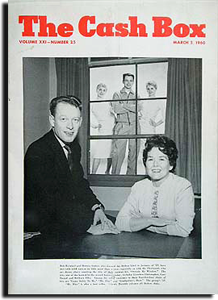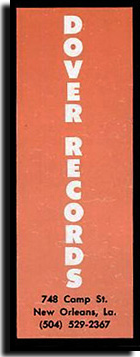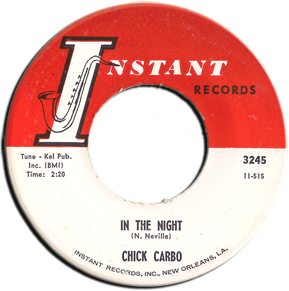AN INTRODUCTION TO THE COSIMO CODE
- A brief explanation of The Cosimo Code and what it represents
by John Broven
 Cosimo Matassa is renowned as operating the only recording studios of note in New Orleans from 1946 with J&M Studio, and then from 1956 to 1968 with the Cosimo Recording Studios. It was at these studios that the New Orleans R&B sounds were born that influenced Rock and Roll music internationally. His work has been recognized by a Grammy award in 2007 and induction into the Rock and Roll Hall of Fame in 2012.
Cosimo Matassa is renowned as operating the only recording studios of note in New Orleans from 1946 with J&M Studio, and then from 1956 to 1968 with the Cosimo Recording Studios. It was at these studios that the New Orleans R&B sounds were born that influenced Rock and Roll music internationally. His work has been recognized by a Grammy award in 2007 and induction into the Rock and Roll Hall of Fame in 2012.
 In October 1960, Matassa introduced a new sequential master tape series starting at 100 with clients allocated individual prefixes. This series ran until the demise of the Cosimo Recording Studios in 1968, and was continued after a fashion with the new Jazz City Recording Studios until 1977. By annotating the series for the first time, we are able to get a better all-round picture of the recording sessions carried out at the Cosimo studios by artists, labels and producers as New Orleans R&B morphed into Soul; Blues, Gospel, Doo-Wop, Pop and Garage Rock were also recorded. Ergo, the Cosimo Code is gradually being unravelled.
In October 1960, Matassa introduced a new sequential master tape series starting at 100 with clients allocated individual prefixes. This series ran until the demise of the Cosimo Recording Studios in 1968, and was continued after a fashion with the new Jazz City Recording Studios until 1977. By annotating the series for the first time, we are able to get a better all-round picture of the recording sessions carried out at the Cosimo studios by artists, labels and producers as New Orleans R&B morphed into Soul; Blues, Gospel, Doo-Wop, Pop and Garage Rock were also recorded. Ergo, the Cosimo Code is gradually being unravelled.
 In quoting dates for the Billboard and Cash Box trade magazine reviews, we are able to assemble reliable dating-guide markers which are particularly valuable with the smaller independent labels. Nevertheless, there are still many gaps in the listing, caused principally by certain labels such as Imperial and Minit having their own master sequences. In the absence of the original log book (if only!), we will attempt to denote these 'non-Code' recordings on separate pages.
In quoting dates for the Billboard and Cash Box trade magazine reviews, we are able to assemble reliable dating-guide markers which are particularly valuable with the smaller independent labels. Nevertheless, there are still many gaps in the listing, caused principally by certain labels such as Imperial and Minit having their own master sequences. In the absence of the original log book (if only!), we will attempt to denote these 'non-Code' recordings on separate pages.
 What the Code does not show, as well, is all the unissued recordings/alternate takes, although we hope to assemble some of this information in the course of time. Likewise, without the log, very few recording dates are known (these will be shown as they surface from tape boxes, session sheets, etc.). Other pages will include a note of hit records and interview transcripts with Cosimo Mattassa and assistant Bert Frilot, among others.
What the Code does not show, as well, is all the unissued recordings/alternate takes, although we hope to assemble some of this information in the course of time. Likewise, without the log, very few recording dates are known (these will be shown as they surface from tape boxes, session sheets, etc.). Other pages will include a note of hit records and interview transcripts with Cosimo Mattassa and assistant Bert Frilot, among others.
The publication of The Cosimo Code inevitably raises many questions, which we hope will be answered in the future. For example, which Meters recordings were cut at Cosimo, Jazz City and elsewhere in the late 1960s? Indeed, what is the under-researched story behind Jazz City studios? Which labels from the Gulf Coast patronized Cosimo's studios? Crucially, what is the whole story behind the collapse of Matassa's Dover organization, and what ever became of all the 1960s master tapes when it fell?
Credit should go to Davie Gordon, of Scotland, for kick-starting this project after he detected the numerical sequence and then compiled the first listing. Since then, John Broven (author of Walking to New Orleans aka Rhythm & Blues in New Orleans), Peter Gibbon (the Ace Records consultant and leading discographer), and John Ridley (aka Sir Shambling) have added to the listing, as has Red Kelly (aka the Soul Detective) who has done the spade work in preparing The Cosimo Code for Internet publication.
 For all the great research work accomplished, it's rather incredible there is still much more to be done! Please join the team by examining the 45s in your collections, discographies, the Internet (YouTube and eBay in particular), and participating in our quest as we continue to fill in the gaps in what will hopefully be a prolonged work in progress.
For all the great research work accomplished, it's rather incredible there is still much more to be done! Please join the team by examining the 45s in your collections, discographies, the Internet (YouTube and eBay in particular), and participating in our quest as we continue to fill in the gaps in what will hopefully be a prolonged work in progress.
At the end of the day, The Cosimo Code is an affectionate tribute to the great deeds of Matassa and the musicians of New Orleans and the South.
- John Broven, March 2013


